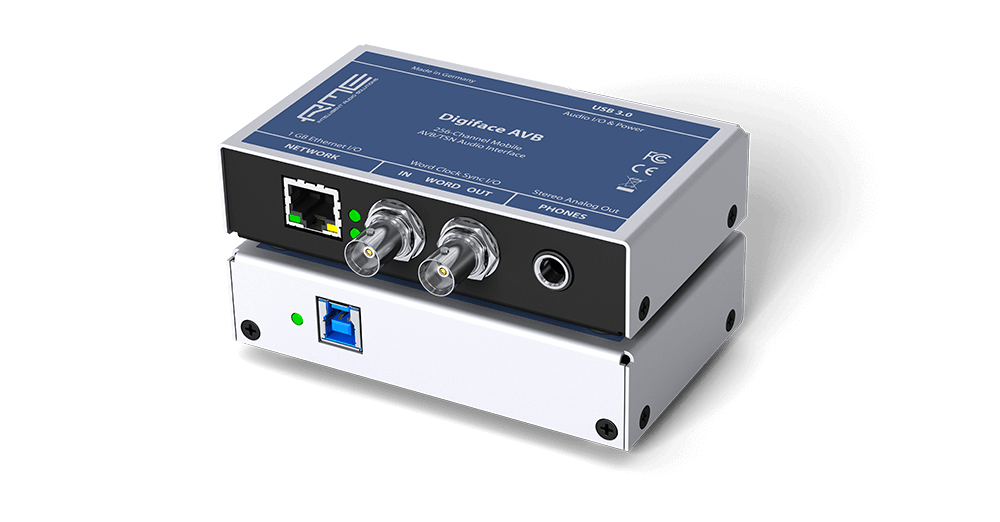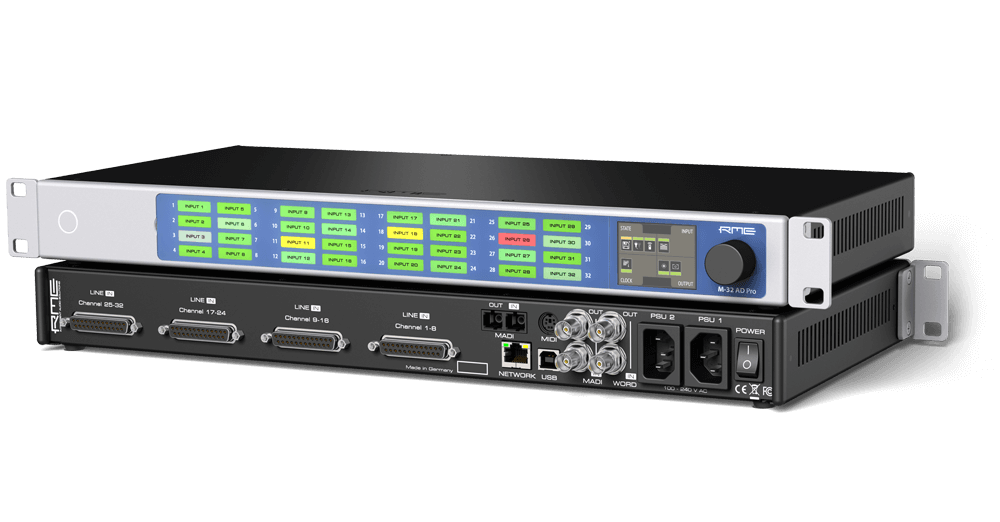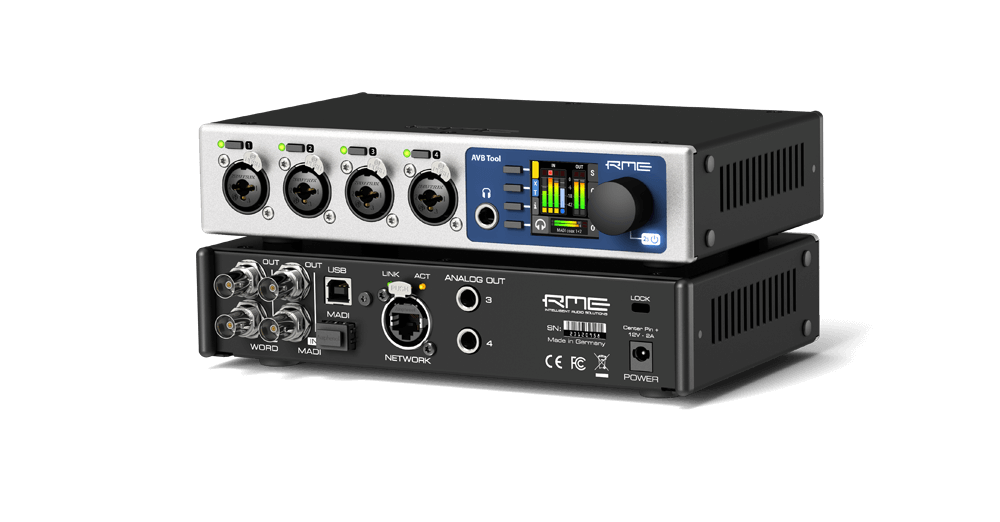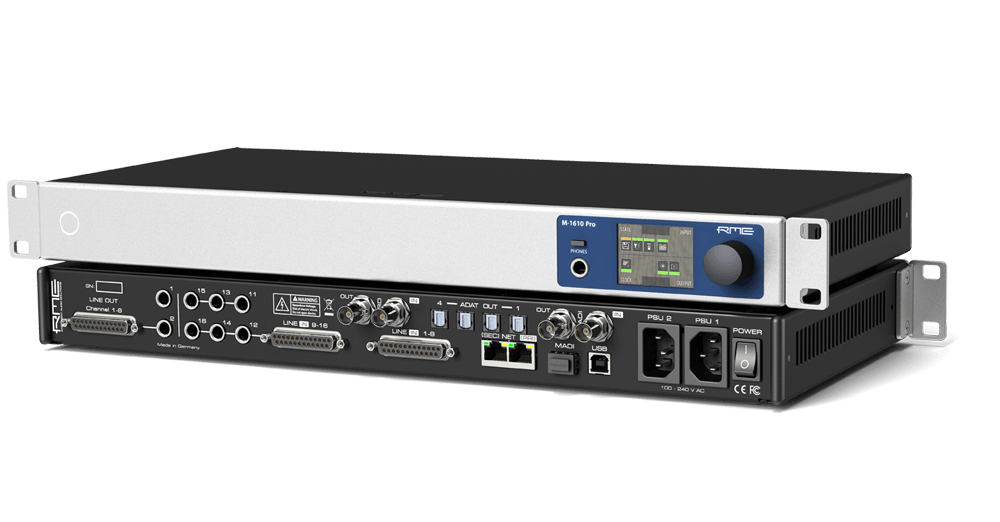12Mic
12-Kanal digital gesteuerter Mikrofonvorverstärker mit AVB & MADI
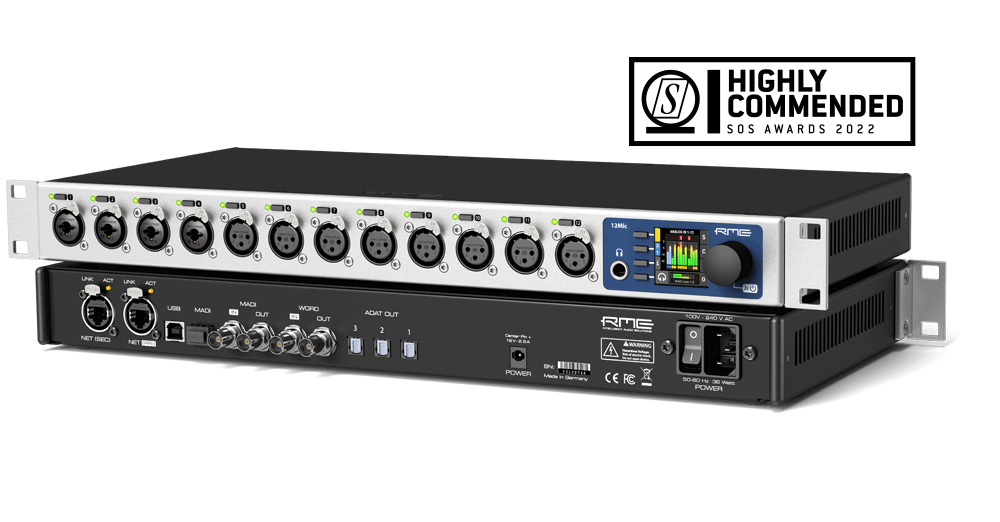

Anschlüsse und Features
Der erste RME-Vorverstärker für Audionetzwerke
Der RME 12Mic verfügt über zwölf Mikrofon- und Line-Eingänge mit kompromissloser Digitalwandlung in Studioqualität, fernsteuerbaren Gain-Pegeln, integrierter MADI- und AVB-Konnektivität sowie einer Vielzahl zusätzlicher Funktionen – der perfekte Begleiter für jedes professionelle Recording-Setup.
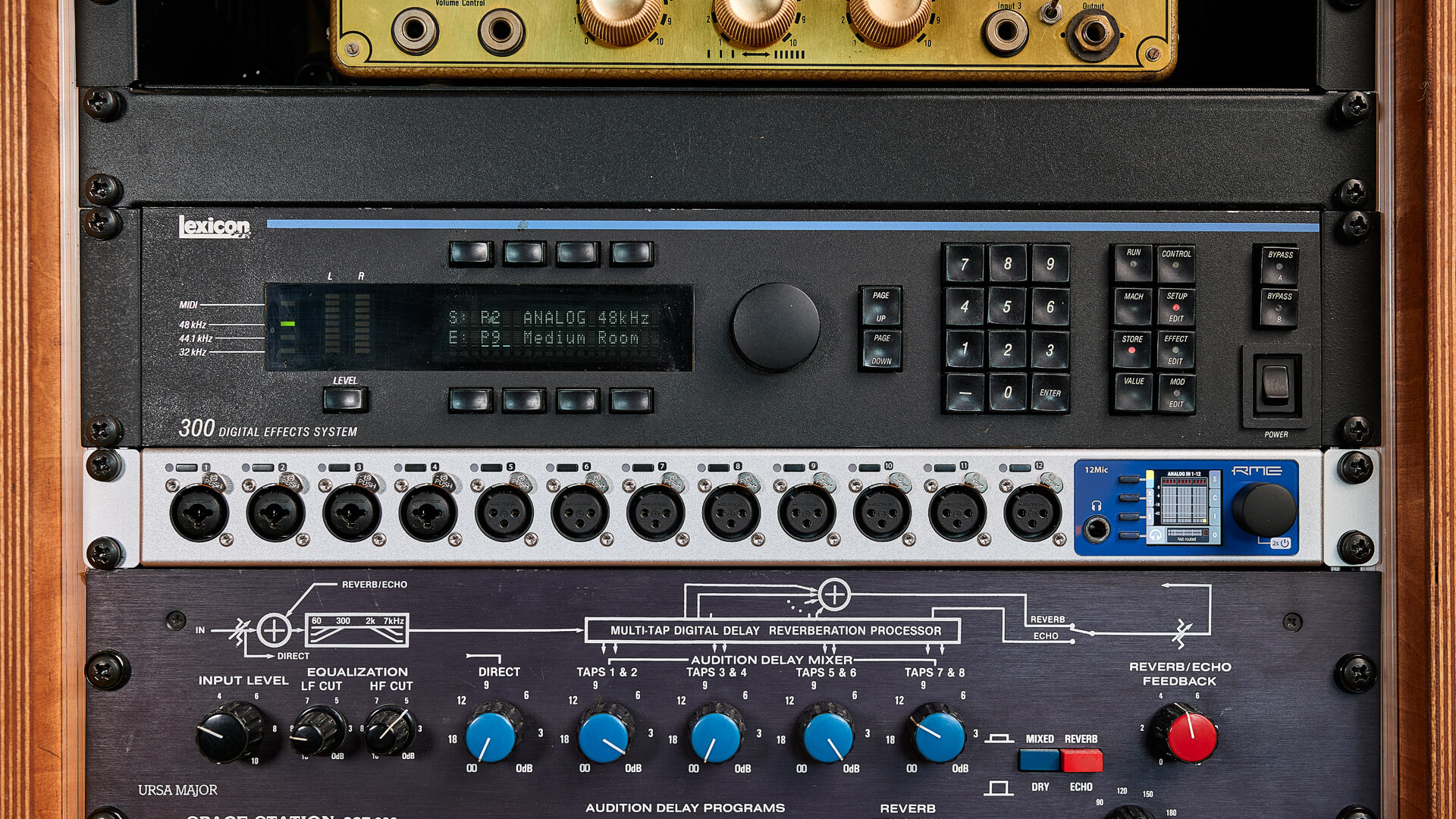
Die neuste Generation RME Audio AVB Netzwerk-Geräte.
Zwölf transparente Mikrofonvorverstärker für eine außergewöhnliche Wandler-Performance
Die Mikrofon-Eingangskanäle ohne PAD-Schalter bieten eine Verstärkung bis zu 75 dB für Signale bis zu +18 dBu. Wandlerseitig glänzt der 12Mic mit einem herausragenden Signal-Rauschabstand auf allen Kanälen. Die zwölf frontseitigen XLR-Anschlüsse verarbeiten jeweils Mikrofon- und Line-Signale, von denen die ersten vier als Kombianschlüsse für TRS-Stecker ausgeführt sind und den Anschluss hochohmiger Instrumentensignale (Hi-Z) unterstützen.
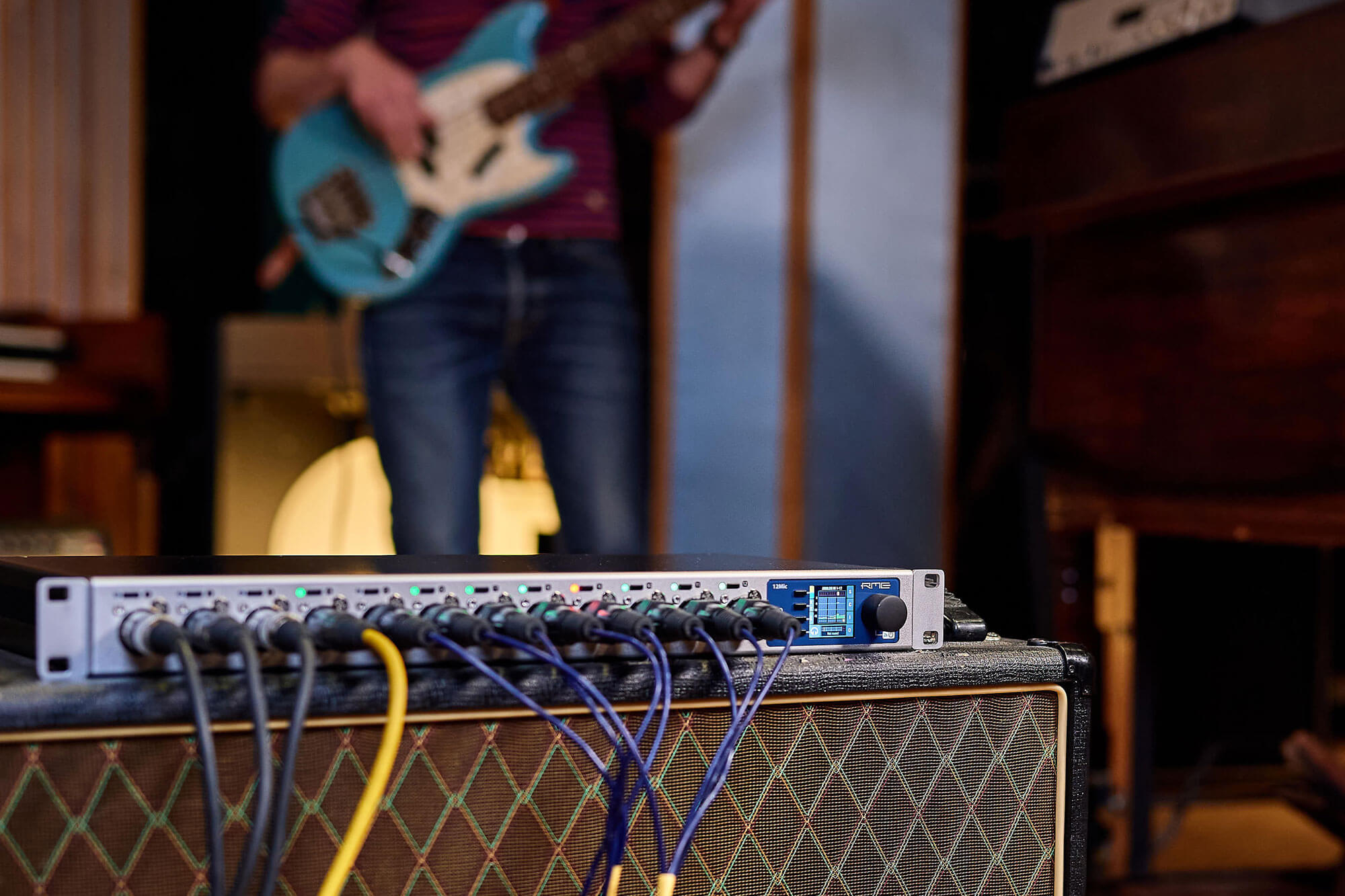
Vier TRS Kombianschlüsse mit schaltbarer hoher Impedanz (Hi-Z) für Instrumente.
MADI & ADAT für maximale Flexibilität
MADI-Ein- und Ausgänge stehen in koaxialer und optischer Ausführung (über ein SPF-Modul) zur Verfügung und unterstützen die Verkettung, Zusammenführung und Wandlung von MADI-Signalen mit extrem niedriger Latenz. Die drei optischen ADAT-Ausgänge ermöglichen die Übertragung von bis zu 24 Kanälen im Single-Speed-Modus (z.B. eine Kombination aus Mikrofoneingängen, MADI- und AVB-Signalen) bzw. bis zu 12 Ausgangskanälen bei 96 kHz Samplerate und gewährleisten die Kompatibilität mit einer Vielzahl von Audio Interfaces. Darüber hinaus lassen sich auch die ADAT-Ports zum Senden von Monitor-Mischungen aus AVB- oder MADI-Eingangssignalen auf externe DA-Wandler und/oder Kopfhörerverstärker verwenden.
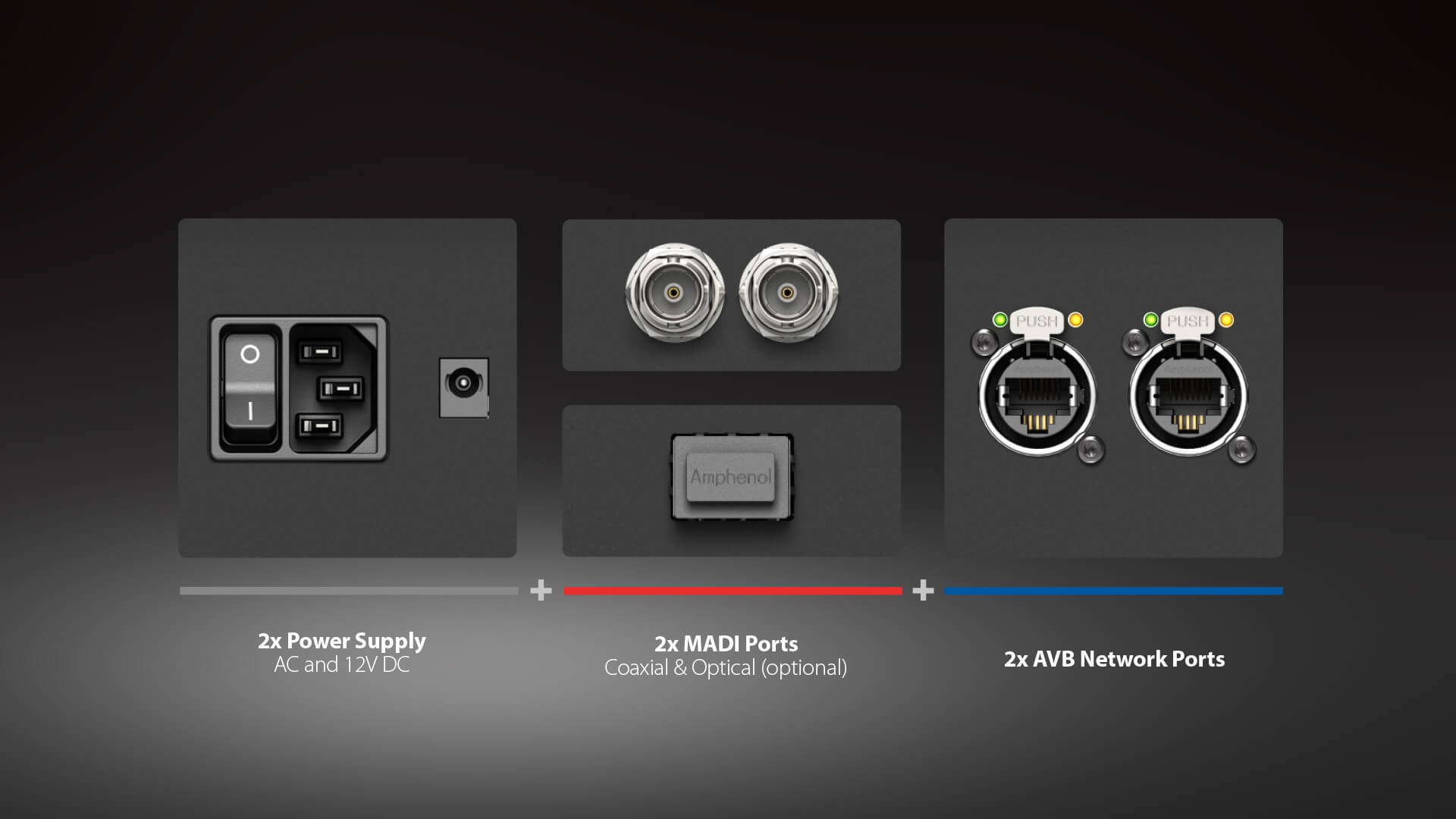
Bauteile für mehrstufige Sicherheit machen das 12Mic zu einem perfekten Begleiter für jede Art von Live-Sound-Anwendungen.
Zwei vollständig redundante Netzwerk-Anschlüsse
Erstmals präsentiert RME ein AVB-Gerät mit zwei vollständig redundanten Netzwerk-Ports auf Basis der MILAN-Richtlinien. Der RME AVB Core setzt die IEEE-Standards für Audio Streaming, Geräteerkennung und Steuerung konsequent um. Auf diese Weise werden RME-Geräte von jedem AVB-Controller erkannt und lassen sich umfassend steuern, so dass herstellerspezifische Steuerprotokolle der Vergangenheit angehören. Jedes am 12Mic eintreffende Signal lässt sich mit fester Latenz und garantierter Bandbreite über ein Netzwerk streamen, ohne auf einen Switch zurückgreifen zu müssen.
Plug & Play – schnelle Nutzerinteraktion
Alle Gerätezustände lassen sich mittels Drehgeber und mehreren Tastern unmittelbar über die Frontplatte steuern und bieten einen komfortablen und direkten Zugriff auf sämtliche Funktionen. Darüber hinaus können die RME AVB-Geräte über ein Web-Interface oder eine beliebige Netzwerk-Verbindung (inkl. W-LAN) umfassend ferngesteuert werden und ermöglichen das schnelle Erstellen von Gain-Gruppen, das Aktivieren/Deaktivieren der Phantomspeisung sowie das Routen von Signalen auf den Kopfhörerausgang zu Monitoringzwecken.
Die integrierte Routing-Matrix ermöglicht das schnelle Routen jedes analogen Eingangs – sowie aller digitalen Signale und AVB-Streams – direkt auf den Kopfhörerausgang. Auf diese Weise gestaltet sich die Lösung von Signal-, Clocking-, Verbindungs- oder anderen Problemen einfach und effizient.
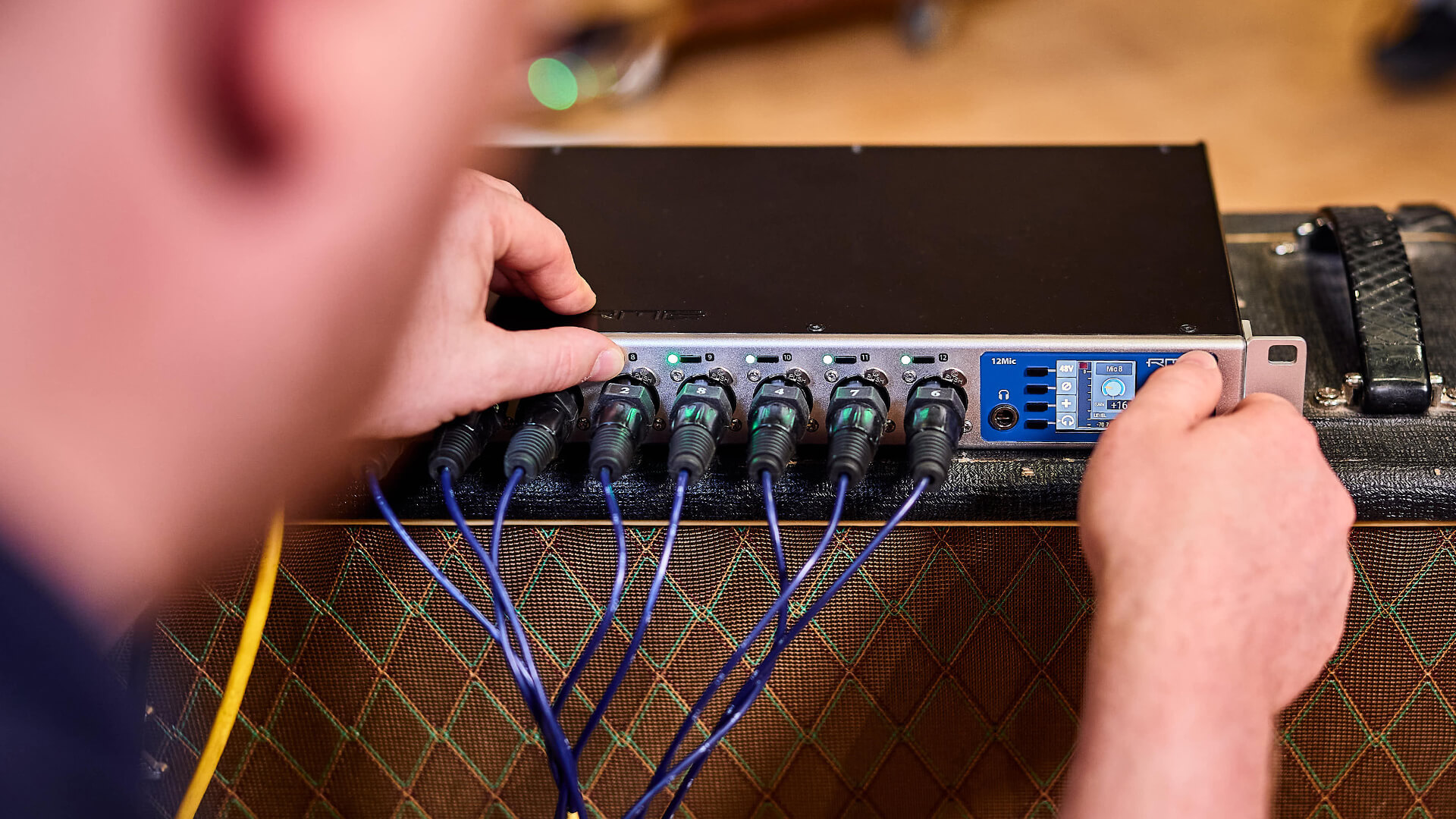
Die 12Mic-Benutzeroberfläche wurde für eine schnelle Konfiguration & Steuerung optimiert.
SteadyClock FS - Referenzklasse für digitale Taktung
Für digitales Audio ist die Taktung, oft „Clocking“ genannt, von entscheidender Wichtigkeit. Sie bildet die Referenz für die Abfolge der Audio-Bits. Leider ist dieser Referenztakt oft nicht so stabil, wie er theoretisch sein sollte. Der 12Mic bietet deshalb die volle SteadyClock FS Unterstützung für niedrigsten Jitter und höchste Jitterimmunität.
Das garantiert hervorragende Leistung in allen Clock Modi und eine qualitative hochwertige analoge Konvertierung, damit Sie Ihren Mix so hören, wie er auch tatsächlich klingt. Die digitale Formatkonvertierung in RME Produkten erfolgt ohne Verlust oder Beeinträchtigung, und SteadyClock FS stellt sicher, dass immer ein präzises Klangbild ohne Beeinträchtigung ausgegeben wird. Dies hilft bei der Optimierung von Aufnahmen und Mischungen, denn dadurch bekommt das Klangspektrum insgesamt mehr Tiefe und Klarheit.
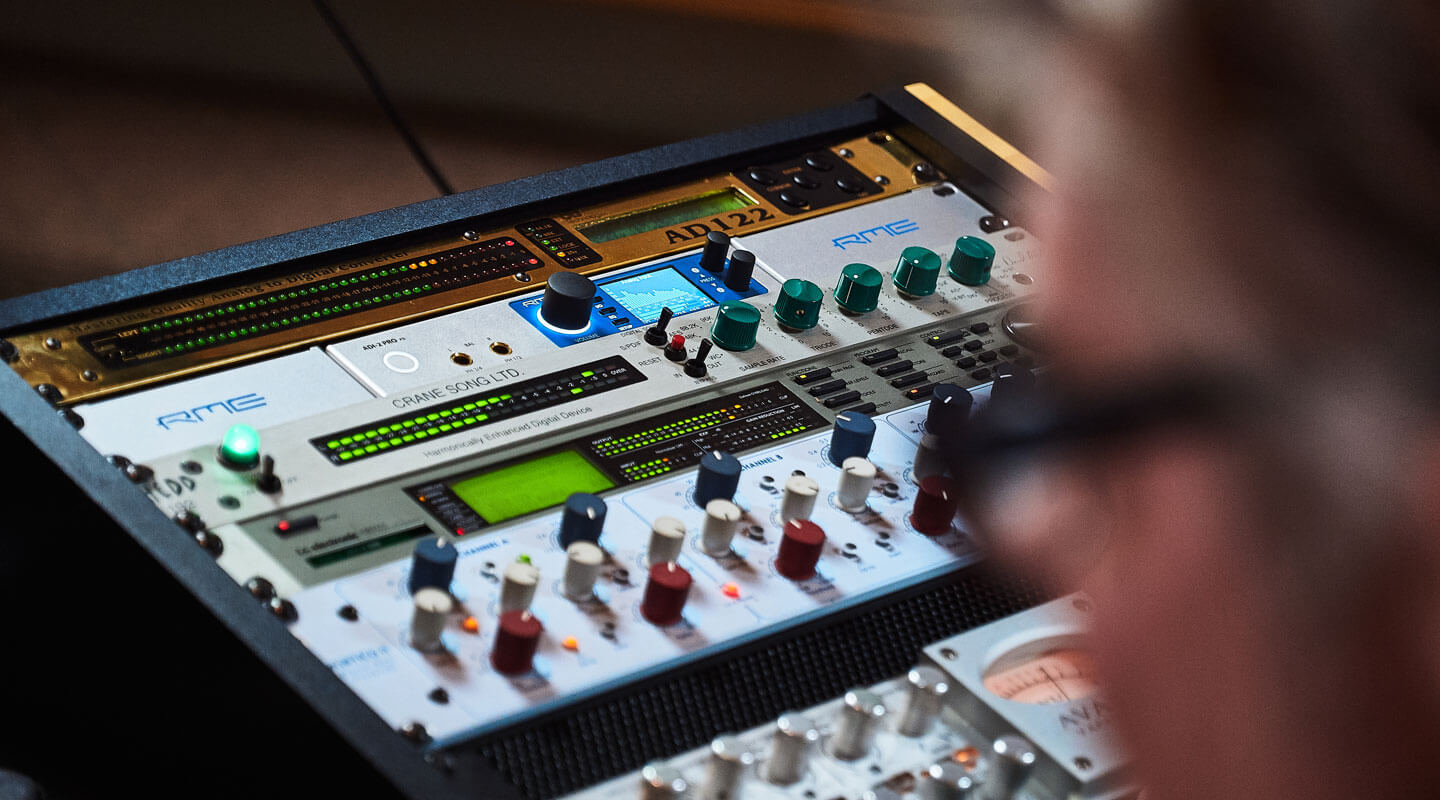
SteadyClock FS Technologie aus der zahllosen preisgekrönten ADI-2-Serie.
About MADI - Multi Channel Digital Audio Protocol
MADI is a protocol that has evolved alongside RME to be the most widely accepted multi channel digital audio protocol on the market. RME’s MADI-based systems deliver incredible reliability, particularly in applications where failure is not an option.
Zubehör
Optisches MADI SFP-Modul (optional erhältlich)
Dieses Modul erweitert kompatible RME-Geräte mit einem optischen SFP-Transceiver. Bis zu 64 Audiokanäle können dann zu anderen MADI-Geräten gesendet und von anderen MADI-Geräten empfangen werden. DAS RME SFP-Modul ist in einer Multi-Mode- und in einer Single-Mode-Version erhältlich, es kann bei eingeschaltetem RME MADI -Gerät eingesetzt und entfernt werden. Es ist nicht notwendig, das Gerät auszuschalten.
Tech-Specs
Inputs
XLR In 1-12:
- Input: XLR, electronically balanced
- Input impedance: 3.4 kOhm
- Gain range: 75 dB, 1 dB steps
- Resolution AD: 24 bit
- Frequency response @ 44.1 kHz, -0.1 dB: 8 Hz – 20.8 kHz
- Frequency response @ 96 kHz, -0.5 dB: 4 Hz – 29.2
- Frequency response @ 192 kHz, -1 dB: 3 Hz – 43.7
- THD @ 30 dB gain: < -110 dB, < 0.00032 %
- THD+N @ 30 dB gain: < -104 dB, < 0.00063 %
- Channel separation: > 110 dB
- Signal to Noise ratio (SNR): > 117 dB RMS unweighted, > 120 dB(A)
- Equivalent Input Noise (EIN), 30 dB Gain: 123 dB RMS unweighted, 125.5 dB(A) @ 150 Ohm
- Maximum input level, Gain 0 dB: +18 dBu
- Maximum input level, Gain 75 dB: -57 dBu
TRS In 1-4:
As above, but:
- Signal to Noise ratio (SNR): 115 dB RMS unweighted, 118 dBA
- TRS jack, balanced
- Gain range: 42 dB, 1 dB steps
- Maximum input level, Gain 8 dB: +20 dBu
- Maximum input level, Gain 50 dB: -22 dBu
- Switchable high impedance (unbalanced TS): 1 MOhm
MADI:
- Coaxial via BNC, 75 Ohm, according to AES10-1991
- Optical via optional SFP module
- 62.5/125 and 50/125 compatible
- Accepts 56 channel and 64 channel mode, plus 96k Frame
- Single Speed: up to 64 channels 24 bit 48 kHz
- Double Speed: up to 32 channels 24 bit 96 kHz
- Quad Speed: up to 16 channels 24 bit 192 kHz
Word Clock:
- 75 ohm Word Clock BNC connectivity
- Support 44.1kHz - 192kHz
- Support full or single speed operation
- SteadyClock FS extracts low jitter clock signal
- Intelligent Clock Control switches clock source seamlessly
Outputs
Phones 1/2:
- Resolution: 24 Bit
- Noise (DR): 115 dB RMS unweighted, 118 dBA
- Frequency response @ 44.1 kHz, -0.5 dB: 9 Hz – 22 kHz
- Frequency response @ 96 kHz, -0.5 dB: 9 Hz – 45 kHz
- Frequency response @ 192 kHz, -1 dB: 8 Hz - 75 kHz
- THD+N: < -100 dB, < 0.001 %
- Channel separation: > 110 dB
- Output: 6.3 mm TRS stereo (unbalanced) or mono (balanced) jack
- Maximum output level at 0 dBFS: +13 dBu (unbalanced), +19 dBu (balanced)
MADI:
- Coaxial via BNC, 75 Ohm, according to AES10-1991
- Optical via optional SFP module
- 62.5/125 and 50/125 compatible
- Accepts 56 channel and 64 channel mode, plus 96k Frame
- Single Speed: up to 64 channels 24 bit 48 kHz
- Double Speed: up to 32 channels 24 bit 96 kHz
- Quad Speed: up to 16 channels 24 bit 192 kHz
ADAT:
- 3 x TOSLINK
- Quad Speed (S/MUX4): 1 x 2 channels 24 bit 192 kHz
Word Clock:
- 75 ohm Word Clock BNC connectivity
- Support 44.1kHz - 192kHz
- Support full or single speed operation
- SteadyClock FS extracts low jitter clock signal
- Intelligent Clock Control switches clock source seamlessly
General
- 2x RJ45 1 GigE AVB, 8 streams (each up to 16 ch.) per direction with redundancy
- MADI input redundancy (requires optional SFP module)
- Internal routing of up to 268x282 channels
- 19” enclosure 1 unit height
- 1,54” full color display with control knob and four buttons for convenient, direct access to all features
- SteadyClock FS - ultra-low jitter digital clock technology
- Remote control via HTTP, JSON, IEEE 1722.1 ATDECC, MIDI over MADI
- internal PSU, optional 12V DC redundant power supply
- USB 2.0 (for remote control and firmware updates)
- DC-coupled outputs
Hardware Specifications
- Dimensions: 440 x 44 x 243 mm (17.3 x 1.7 x 9.6 inches)
- Weight: 2.8 kg (6.2 lbs)
- Package: 560 x 315 x 115 mm (22.1 x 12.4 x 4.5 inches)
- Conformity: CE, FCC, WEEE, RoHS
- Power supply: internal 30 W 100-240 V AC, external 12 V 2.5 A DC (optional)
- Power consumption: typ. 20 W, standby 0.5W
All specifications are subject to change without notice.
Treiber
Firmware 2.0.0. Main update. Adds MILAN certification. Carefully read the instructions in the readme.pdf!
Firmware 1.7.1, 06/11/2023. Main update. Carefully read the instructions in the readme.pdf!
Version 2.0.0 with support for the 12Mic, 12Mic-D, AVB Tool and OctaMic XTC, requires macOS 10.15 or newer!
Version 2.0.0 with support for the 12Mic, 12Mic-D, AVB Tool and OctaMic XTC, requires macOS 10.15 or newer!
Version 1.0.0 with support for the 12Mic, AVB Tool, and OctaMic XTC.
Version 2.0.0 with support for the 12Mic, 12Mic-D, AVB Tool and OctaMic XTC, requires Windows 10 or newer!
Version 1.0.0 with support for the 12Mic, AVB Tool, and OctaMic XTC.


